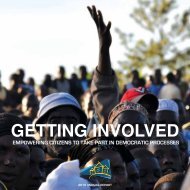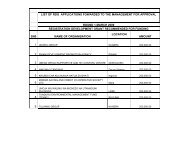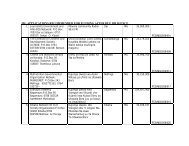for Civil Society for Civil Society - The Foundation for Civil Society
for Civil Society for Civil Society - The Foundation for Civil Society
for Civil Society for Civil Society - The Foundation for Civil Society
Create successful ePaper yourself
Turn your PDF publications into a flip-book with our unique Google optimized e-Paper software.
| BIG Question |<br />
Why too many<br />
projects but<br />
handful results?<br />
Fridah Mwakasyuka<br />
<strong>The</strong>re are many<br />
development<br />
projects being<br />
implemented in<br />
various sectors<br />
throughout the<br />
country. <strong>The</strong> aim<br />
is to contributing<br />
to the overall<br />
fmwakasyuka@thefoundation-tz.org goal of poverty<br />
reduction. <strong>The</strong><br />
government and civil society sector are some<br />
of the main players involved in designing,<br />
implementing and managing development<br />
projects. It is disheartening to note, the pace<br />
of change as a result of implementation of<br />
projects is minute in comparison to the inputs.<br />
<strong>The</strong> main reason is that we have projects<br />
implemented without having the end result<br />
in mind. Writes Fridah Mwakasyuka<br />
Some of such projects have proved to have<br />
negative or no impact to the community.<br />
Instead of reducing poverty they perpetuate<br />
deprivation. No wonder, more people<br />
are becoming more and more vulnerable to<br />
poverty each day. Many projects by CSOs<br />
begin and end with workshops <strong>for</strong> awareness<br />
creation on this policy or that law.<br />
<strong>The</strong>re is no linkage as to what local or central<br />
government should do differently. No<br />
wonder then, a big question remains what<br />
next after awareness?<br />
This kind of scenario has promoted me to<br />
discuss development project planning and<br />
management as at the end of the day, the<br />
| 20 |<br />
| www.thefoundation.tz.org |<br />
two values are among determining factors<br />
<strong>for</strong> a project to be able to alleviate poverty<br />
to the expected degree.<br />
Many development projects aim at solving<br />
certain problems in the society. That is why,<br />
the idea of a project should be well thought<br />
of- that is, it should address specific problems<br />
facing specified target.<br />
<strong>The</strong> overall aim of any development project<br />
is to bring positive change to the specified<br />
target. This calls <strong>for</strong> projects then to be developed<br />
taking into consideration the views<br />
of stakeholders, particularly the beneficiaries.<br />
Another issue that needs a lot of consideration<br />
is – factors contributing to the problem.<br />
This calls <strong>for</strong> assessment of the needs of a<br />
people so as to correctly identify a project.<br />
<strong>The</strong>n assessment should be done to gain insight<br />
about the problem that an institution<br />
(CSO) intends to address.<br />
It is of uttermost importance to involve expected<br />
beneficiaries of a project at its <strong>for</strong>mulation<br />
stage as they are the ones who<br />
knows better the problems they face. This<br />
can be done at communal meetings and<br />
focus groups discussions (FGD). Other techniques<br />
which can be used to assess community<br />
needs are community mapping and<br />
participatory appraisal.<br />
<strong>The</strong> <strong>Foundation</strong> Newsletter<br />
What does it take to have a project<br />
become successful?<br />
It should be noted that if the whole process<br />
of planning and management is open and<br />
transparent and is geared to enabling beneficiaries<br />
own the processes and results of the<br />
project, it’s more likely to become successful.<br />
After all, the outcome of the project is<br />
measured as a noticeable change which can<br />
be sustained by the project beneficiaries.<br />
Can the project really be able to make<br />
use of all the diverse stakeholders?<br />
This is not feasible. This calls <strong>for</strong> the need to<br />
identify stakeholders to involve. This is done<br />
through undertaking stakeholders’ analysis,<br />
which will help to identifying primary and<br />
secondary stakeholders. <strong>The</strong> first are those<br />
who directly will be affecting or be affected<br />
by the project while the latter are those who<br />
indirectly will be affecting or be affected by<br />
the project.<br />
During the project planning stage, the identified<br />
problems should be carefully and<br />
critically analyzed by all stakeholders. <strong>The</strong><br />
analysis of the problem to be solved by<br />
the project should include identifying root<br />
causes and effects of the snag. If not well<br />
analyzed, the problem will be only partially<br />
solved.<br />
After the analysis of the problem, then objectives<br />
should be set, describing the desired<br />
positive outcome, the situation of the problem,<br />
root causes and effects.<br />
Other things to consider<br />
<strong>The</strong>re are many other things that should be<br />
embraced while planning a project. This<br />
includes the development of the <strong>The</strong>ory of<br />
Change <strong>for</strong> the project. I am right to say<br />
that many projects do not start with the end<br />
in mind. <strong>The</strong> question is the epitaph. This<br />
mean what the project will bring and leave<br />
to the members of the community once the<br />
project is over. To answer this question you<br />
will have set you a benchmark that you will<br />
use to measure and see if the project has<br />
achieved the intended goal. Remember to<br />
set only one main objective. And at least 3<br />
specific objectives (too many objectives and

















